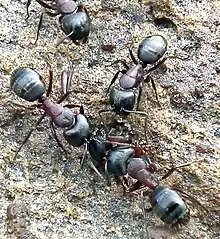| Allocordyceps | |
|---|---|
 | |
| An image of a carpenter ant species, the type of species that Allocordyceps parasitize. | |
| Scientific classification | |
| Kingdom: | |
| Division: | |
| Phylum: | |
| Class: | Sordariomyces |
| Order: | |
| Family: | |
| Genus: | Allocordyceps Poinar |
| Type species | |
| Allocordyceps baltica | |
Allocordyceps is a genus of parasitic fungus in the order Hypocreales that parasitizes carpenter ants.[1][2] The fossil of Allocordyceps represents the oldest known fossil of an ant-parasitizing fungus before Ophiocordyceps. The only species within this genus is Allocordyceps baltica.[3][4]
Description
Allocordyceps is characterized by its ascoma being an orange color, stalked and cusp shaped. It also has a pair of partially immersed perithecia that emerges from its rectum. When parasitized by Allocordyceps, separate stromata with separate mycelium emerge from a carpenter ant's neck and abdomen.[4]
References
- ↑ "Carpenter Ants Management Guidelines--UC IPM". ipm.ucanr.edu. Retrieved 2023-10-25.
- ↑ "Camponotus - an overview | ScienceDirect Topics". www.sciencedirect.com. Retrieved 2023-10-25.
- ↑ "How a parasitic fungus turns ants into 'zombies'". Animals. 2019-04-18. Archived from the original on February 21, 2021. Retrieved 2023-10-25.
- 1 2 Poinar, George; Maltier, Yves-Marie (2021-11-01). "Allocordyceps baltica gen. et sp. nov. (Hypocreales: Clavicipitaceae), an ancient fungal parasite of an ant in Baltic amber". Fungal Biology. 125 (11): 886–890. doi:10.1016/j.funbio.2021.06.002. ISSN 1878-6146.
This article is issued from Wikipedia. The text is licensed under Creative Commons - Attribution - Sharealike. Additional terms may apply for the media files.